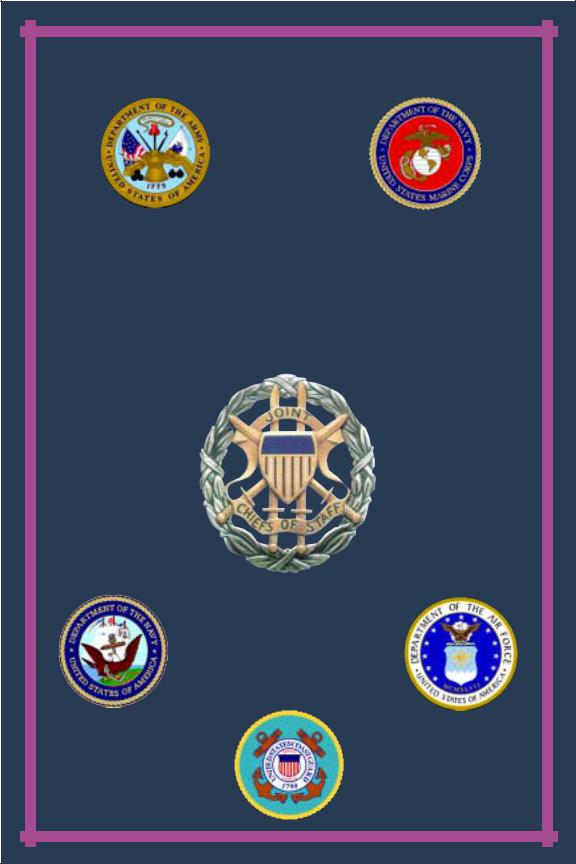
US Army Dictionary of Military Terms
.pdf
Joint Publication 1-02
Department of Defense
Dictionary of
Military and Associated
Terms
12 April 2001
(As Amended Through
23 January 2002)

PREFACE
1. Scope
The Department of Defense Dictionary of Military and Associated Terms (short title: Joint Pub 1-02 or JP 1-02) sets forth standard US military and associated terminology to encompass the joint activity of the Armed Forces of the United States in both US joint and allied joint operations, as well as to encompass the Department of Defense (DOD) as a whole. These military and associated terms, together with their definitions, constitute approved DOD terminology for general use by all components of the Department of Defense. The Secretary of Defense, by DOD Directive 5025.12, 23 August 1989, Standardization of Military and Associated Terminology, has directed the use of JP 1-02 throughout the Department of Defense to ensure standardization of military and associated terminology.
2. Purpose
This publication supplements standard English-language dictionaries with standard terminology for military and associated use. However, it is not the intent of this publication to restrict the authority of the joint force commander (JFC) from organizing the force and executing the mission in a manner the JFC deems most appropriate to ensure unity of effort in the accomplishment of the overall mission.
3.Application — DOD and NATO Activities
JP 1-02 is promulgated for mandatory use by the Office of the Secretary of Defense, Military Departments, Joint Staff, combatant commands, Defense agencies, and any other DOD components. DOD terminology herein is to be used without alteration unless a distinctly different context or application is
intended. To provide a common interpretation of terminology at home and abroad, US officials, when participating in the North Atlantic Treaty Organization (NATO) or dealing with NATO matters, will use NATO terminology. When a NATO standard for a term or definition does not exist, applicable DOD terminology (if any) may be used.
NoteconcerningDOD-NATOStandardization:
The United States is a signatory to NATO Standardization Agreement (STANAG) 3680, which ratifies the NATO Glossary of Terms and Definitions (English and French) (short title: AAP-6). Under the provisions of STANAG 3680, AAP-6 is established as the primary glossary for NATO. The United States carries out its obligation to implement STANAG 3680 in the following manner: (a) English-language entries approved for AAP-6 may be proposed by DOD elements for inclusion in JP 1-02 as DOD-NATO entries. The purpose of such proposals is to increase multinational standardization. After DOD-wide staffing by the US NATO Military Terminology Group (USNMTG), terminology so approved for inclusion in JP 1-02 and DOD-wide use will appear, along with DOD-only entries, in JP 1-02 with an asterisk in parentheses after the term to denote DOD-NATO standardization of terminology, referred to as “alignment” in NATO. (b) As stated in paragraph 3, US officials will adhere to NATO terminology when engaged in NATO matters, provided that applicable terminology exists. (c) An electronic copy of AAP-6 is provided under “Other Publications” at the internet address cited in paragraph 7.
4. Criteria for Terms
The following criteria are used to determine the acceptability of terminology for inclusion in JP 1-02:
i

Preface
a. Inadequate coverage in a standard, commonly accepted dictionary, e.g., by Merriam-Webster.
by the Director for Operational Plans and Joint Force Development (J-7), Joint Staff.
b.Terminology should be of general military or associated significance. Technical or highly specialized terms may be included if they can be defined in easily understood language and if their inclusion is of general military or associated significance.
c.Terms for weaponry are limited to generic weapon systems.
d.Unless there are special reasons to the contrary, terms and definitions are not to consist of or contain abbreviations or other shortened forms, e.g., acronyms.
e.Only UNCLASSIFIED terminology will be included.
f.Dictionary entries will not be provided for prowords, code words, brevity words, or NATO-only terms.
g.Dictionary entries will not be Servicespecific or functionality-specific unless they are commonly employed by US joint forces as a whole.
h.Dictionary entries will not consist of components or sub-components contained in missiles, aircraft, equipment, weapons, etc.
6. Publication Format
This edition of JP 1-02 has been published in two basic parts:
a. Main Body. This part of the dictionary contains all terms and definitions approved for use within the Department of Defense, to include those terms and definitions that are approved for both DOD and NATO use. Each entry approved for both DOD and NATO appears with an asterisk in parentheses, i.e., (*), after the term to denote DOD-NATO acceptance.
Note: In rare instances, a term may have a combination of DOD-only definitions and DOD-NATO definitions. In these instances, though an asterisk will appear after the term to denote DOD-NATO standardization, DODonly definitions will be preceded by “DOD only” in parentheses.
b. Appendix A. Appendix A contains a listing of current abbreviations and acronyms in common use within the Department of Defense. This is by no means a complete list of DOD abbreviations and acronyms. Rather, it serves as a guide to current DOD usage in abbreviations and acronyms.
5. Other DOD Dictionaries
Other dictionaries or glossaries for DOD use will be published ONLY AFTER coordination with the USNMTG and approval
7. JP 1-02 on the Internet
JP 1-02 is accessible on-line at the following internet address:
http://www.dtic.mil/doctrine/jel/doddict
ii |
JP 1-02 |

Preface
As changes are approved for JP 1-02, they are added to the internet version, making the internet version of JP 1-02 more up-to-date
than any printed edition. The internet version thus provides the latest changes worldwide between regular printed editions.
For the Chairman of the Joint Chiefs of Staff:
S. A. FRY
Vice Admiral, U.S. Navy
Director, Joint Staff
iii

Preface
Intentionally Blank
iv |
JP 1-02 |

TABLE OF CONTENTS |
|
|
PAGE |
MAIN BODY .................................................................................................................. |
1 |
APPENDIX |
|
A Abbreviations and Acronyms ........................................................................... |
A-1 |
B Terminology Points of Contact .......................................................................... |
B-1 |
C Administrative Instructions ............................................................................... |
C-1 |
v

Table of Contents
Intentionally Blank
vi |
JP 1-02 |

As Amended Through 23 January 2002
A
abort — (*) 1. To terminate a mission for any reason other than enemy action. It may occur at any point after the beginning of the mission and prior to its completion. 2. To discontinue aircraft takeoff or missile launch.
above-the-line publications — The upper level publications in the hierarchy of joint publications which includes capstone, keystone, and other key joint doctrine publications that the Chairman of the Joint Chiefs of Staff signs and are intended to be used by combatant commanders, subunified commanders, joint task force commanders, Service Chiefs, and Joint Staff directors. See also below-the-line publications; capstone publication; joint publication; keystone publications. (JP 1-01)
absolute altimeter — (*) A type of altimeter which measures vertical distance to the surface below, using radio, radar, sonic, laser, or capacitive technology.
absolute dud — A nuclear weapon which, when launched at or emplaced on a target, fails to explode.
absolute filter — (*) A filter capable of cutting off 100% by weight of solid particles greater than a stated micron size.
absolute height — (*) The height of an aircraft directly above the surface or terrain over which it is flying. See also altitude.
absorbed dose — (*) The amount of energy imparted by nuclear (or ionizing) radiation to unit mass of absorbing material. The unit is the rad.
acceptability — Operation plan review criterion. The determination as to whether the contemplated course of action is worth the cost in manpower, materiel, and time
involved; is consistent with the law of war; and is militarily and politically supportable. See also adequacy; feasibility.
access to classified information — The ability and opportunity to obtain knowledge of classified information. Persons have access to classified information if they are permitted to gain knowledge of the information or if they are in a place where they would be expected to gain such knowledge. Persons do not have access to classified information by being in a place where classified information is kept if security measures prevent them from gaining knowledge of the information.
accidental attack — An unintended attack which occurs without deliberate national design as a direct result of a random event, such as a mechanical failure, a simple human error, or an unauthorized action by a subordinate.
accompanying supplies — Unit supplies that deploy with forces.
accountability — The obligation imposed by law or lawful order or regulation on an officer or other person for keeping accurate record of property, documents, or funds. The person having this obligation may or may not have actual possession of the property, documents, or funds. Accountability is concerned primarily with records, while responsibility is concerned primarily with custody, care, and safekeeping. See also responsibility.
accounting line designator — A five-character code, consisting of the target desired ground zero designator and the striking command suffix, to indicate a specific nuclear strike by a specified weapon delivery system on a target
1

As Amended Through 23 January 2002
objective to the operation plan. Also called
ALD.
accuracy of fire — (*) The precision of fire expressed by the closeness of a grouping of shots at and around the center of the target.
accuracy of information — See evaluation.
acoustical surveillance — Employment of electronic devices, including sound-recording, -receiving, or -transmitting equipment, for the collection of information.
acoustic circuit — A mine circuit which responds to the acoustic field of a target. See also mine.
acoustic intelligence — (*) Intelligence derived from the collection and processing of acoustic phenomena. Also called
ACINT.
acoustic jamming — The deliberate radiation or reradiation of mechanical or electroacoustic signals with the objectives of obliterating or obscuring signals that the enemy is attempting to receive and of disrupting enemy weapons systems. See also barrage jamming; electronic warfare; jamming; spot jamming.
acoustic mine — (*) A mine with an acoustic circuit which responds to the acoustic field of a ship or sweep. See also mine.
acoustic minehunting — (*) The use of a sonar to detect mines or mine-like objects which may be on or protruding from the seabed, or buried.
acoustic warfare — (*) Action involving the use of underwater acoustic energy to determine, exploit, reduce, or prevent hostile use of the underwater acoustic spectrum and actions which retain friendly use of the underwater acoustic spectrum.
Also called AW. There are three divisions within acoustic warfare. 1. acoustic warfare support measures. That aspect of acoustic warfare involving actions to search for, intercept, locate, record, and analyze radiated acoustic energy in water for the purpose of exploiting such radiations. The use of acoustic warfare support measures involves no intentional underwater acoustic emission and is generally not detectable by the enemy. Also called AWSM. 2. acoustic warfare countermeasures. That aspect of acoustic warfare involving actions taken to prevent or reduce an enemy’s effective use of the underwater acoustic spectrum. Acoustic warfare countermeasures involve intentional underwater acoustic emissions for deception and jamming. Also called
AWCM. 3. acoustic warfare countercountermeasures. That aspect of acoustic warfare involving actions taken to ensure friendly effective use of the underwater acoustic spectrum despite the enemy’s use of underwater acoustic warfare. Acoustic warfare counter-countermeasures involve anti-acoustic warfare support measures and anti-acoustic warfare countermeasures, and may not involve underwater acoustic emissions. Also called AWCCM.
acoustic warfare counter-countermeasures
— See acoustic warfare Part 3.
acoustic warfare countermeasures — See acoustic warfare Part 2.
acoustic warfare support measures — See acoustic warfare Part 1.
acquire — 1. When applied to acquisition radars, the process of detecting the presence and location of a target in sufficient detail to permit identification. 2. When applied to tracking radars, the process of positioning a radar beam so that a target is in that beam to permit the effective employment of weapons. See also target acquisition.
2 |
JP 1-02 |

As Amended Through 23 January 2002
acquire (radar) — See acquire.
acquisition — See collection (acquisition).
acquisition and cross-servicing agreement
— Agreements negotiated on a bilateral basis with US allies or coalition partners that allow US forces to exchange most common types of support, including food, fuel, transportation, ammunition, and equipment. Authority to negotiate these agreements is usually delegated to the combatant commander by the Secretary of Defense. Authority to execute these agreements lies with the Secretary of Defense, and may or may not be delegated. Governed by legal guidelines, these agreements are used for contingencies, peacekeeping operations, unforeseen emergencies, or exercises to correct logistic deficiencies that cannot be adequately corrected by national means. The support received or given is reimbursed under the conditions of the acquisition and crossservicing agreement. Also called ACSA.
See also cross-servicing; servicing.
(JP 4-07)
action agent — In intelligence usage, one who has access to, and performs actions against, the target.
action deferred — Tactical action on a specific track is being withheld for better tactical advantage. Weapons are available and commitment is pending.
action information center — See air defense control center; combat information center.
action phase — In an amphibious operation, the period of time between the arrival of the landing forces of the amphibious force in the operational area and the accomplishment of their mission. See also amphibious force; amphibious operation; landing force; mission. (JP 3-02)
activation — Order to active duty (other than for training) in the Federal service. See also active duty; federal service. (JP 4-05)
activation detector — (*) A device used to determine neutron flux or density by virtue of the radioactivity induced in it as a result of neutron capture.
active air defense — Direct defensive action taken to destroy, nullify, or reduce the effectiveness of hostile air and missile threats against friendly forces and assets. It includes the use of aircraft, air defense weapons, electronic warfare, and other available weapons. See also air defense. (JP 3-01)
active communications satellite — See communications satellite.
active defense — The employment of limited offensive action and counterattacks to deny a contested area or position to the enemy. See also passive defense.
active duty — Full-time duty in the active military service of the United States. This includes members of the Reserve Components serving on active duty or full-time training duty, but does not include full-time National Guard duty. Also called
AD. See also active duty for training; inactive duty training.
active duty for special work — A tour of active duty for reserve personnel authorized from military and reserve personnel appropriations for work on active or reserve component programs. This includes annual screening, training camp operations, training ship operations, and unit conversion to new weapon systems when such duties are essential. Active duty for special work may also be authorized to support study groups, training sites and exercises, short-term projects, and doing administrative or support functions. By
3
